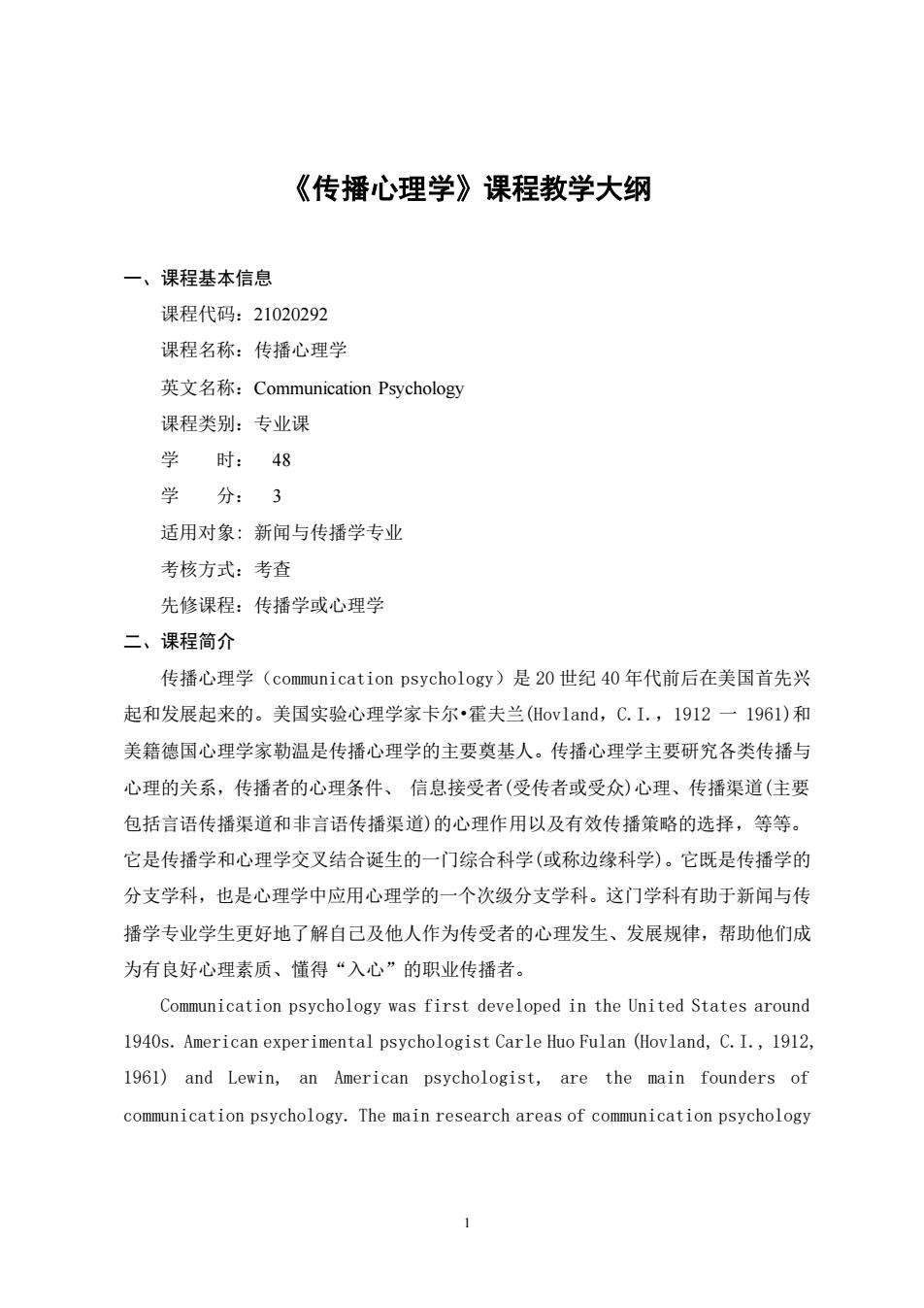
《传播心理学》课程教学大纲 一、课程基本信息 课程代码:21020292 课程名称:传播心理学 英文名称:Communication Psychology 课程类别:专业课 学时:48 学分:3 适用对象:新闻与传播学专业 考核方式:考查 先修课程:传播学或心理学 二、课程简介 传播心理学(communication psychology)是20世纪40年代前后在美国首先兴 起和发展起来的。美国实验心理学家卡尔·霍夫兰(Hovland,C.I.,1912一1961)和 美籍德国心理学家勒温是传播心理学的主要奠基人。传播心理学主要研究各类传播与 心理的关系,传播者的心理条件、信息接受者(受传者或受众)心理、传播渠道(住要 包括言语传播渠道和非言语传播渠道)的心理作用以及有效传播策略的选择,等等。 它是传播学和心理学交叉结合诞生的一门综合科学(或称边缘科学)。它既是传播学的 分支学科,也是心理学中应用心理学的一个次级分支学科。这门学科有助于新闻与传 播学专业学生更好地了解自己及他人作为传受者的心理发生、发展规律,帮助他们成 为有良好心理素质、懂得“入心”的职业传播者。 Communication psychology was first developed in the United States around 1940s.American experimental psychologist Carle Huo Fulan (Hovland,C.I.,1912, 1961)and Lewin,an American psychologist,are the main founders of communication psychology.The main research areas of communication psychology
1 《传播心理学》课程教学大纲 一、课程基本信息 课程代码:21020292 课程名称:传播心理学 英文名称:Communication Psychology 课程类别:专业课 学 时: 48 学 分: 3 适用对象: 新闻与传播学专业 考核方式:考查 先修课程:传播学或心理学 二、课程简介 传播心理学(communication psychology)是 20 世纪 40 年代前后在美国首先兴 起和发展起来的。美国实验心理学家卡尔•霍夫兰(Hovland,C.I.,1912 一 1961)和 美籍德国心理学家勒温是传播心理学的主要奠基人。传播心理学主要研究各类传播与 心理的关系,传播者的心理条件、 信息接受者(受传者或受众)心理、传播渠道(主要 包括言语传播渠道和非言语传播渠道)的心理作用以及有效传播策略的选择,等等。 它是传播学和心理学交叉结合诞生的一门综合科学(或称边缘科学)。它既是传播学的 分支学科,也是心理学中应用心理学的一个次级分支学科。这门学科有助于新闻与传 播学专业学生更好地了解自己及他人作为传受者的心理发生、发展规律,帮助他们成 为有良好心理素质、懂得“入心”的职业传播者。 Communication psychology was first developed in the United States around 1940s. American experimental psychologist Carle Huo Fulan (Hovland, C.I., 1912, 1961) and Lewin, an American psychologist, are the main founders of communication psychology. The main research areas of communication psychology

include:the relationship between psychology and all types of communication; the psychological condition of disseminator and receiver of information, psychological communication channels (including verbal communication and nonverbal communication channels),and effective communication strategies, etc.It is a comprehensive science (or borderline science)at the intersection of communication and psychology.It is not only a branch of communication science,but also a secondary branch of psychology in applied psychology.This discipline helps students majoring in journalism and communication better understand the psychological occurrence and development laws of themselves and others as communicators,and helps them become professional communicators with good psychological quality and know how to "enter the heart". 三、课程性质与教学目的 本课程为专业必修课程。教学目的如下: 1.使学生掌握传播心理学基本知识,包括历史、研究对象和现状等: 2.了解不同传播类型中涉及的心理学知识,熟悉心理学在相关传播领域的应用: 3.了解传播过程中,传播者的心理条件、传播受众的心理、以及传播内容编排 传播策略选择、传播环境中涉及的心理学知识: 4.重点通过掌握传播各环节涉及的心理发生和发展规律,分析现实生活中的传播 相关问题:并能在传播实践中,在深度理解社会主义核心价值观、保持身心健康的基 础上,坚定理想信念,勇于追求真理,敢于探索和创新,做到科学、有效地从事各类 传播活动。 四、教学内容及要求 What is communication psychology? (1)Purpose and requirements Knowledge:clarify the importance of learning communication psychology, master the discipline orientation,research object and content of communication psychology,and understand the curriculum system of
2 include: the relationship between psychology and all types of communication; the psychological condition of disseminator and receiver of information, psychological communication channels (including verbal communication and nonverbal communication channels), and effective communication strategies, etc. It is a comprehensive science (or borderline science) at the intersection of communication and psychology. It is not only a branch of communication science, but also a secondary branch of psychology in applied psychology.This discipline helps students majoring in journalism and communication better understand the psychological occurrence and development laws of themselves and others as communicators, and helps them become professional communicators with good psychological quality and know how to "enter the heart". 三、课程性质与教学目的 本课程为专业必修课程。教学目的如下: 1.使学生掌握传播心理学基本知识,包括历史、研究对象和现状等; 2.了解不同传播类型中涉及的心理学知识,熟悉心理学在相关传播领域的应用; 3.了解传播过程中,传播者的心理条件、传播受众的心理、以及传播内容编排、 传播策略选择、传播环境中涉及的心理学知识; 4.重点通过掌握传播各环节涉及的心理发生和发展规律,分析现实生活中的传播 相关问题;并能在传播实践中,在深度理解社会主义核心价值观、保持身心健康的基 础上,坚定理想信念,勇于追求真理,敢于探索和创新,做到科学、有效地从事各类 传播活动。 四、教学内容及要求 What is communication psychology? (1) Purpose and requirements Knowledge: clarify the importance of learning communication psychology, master the discipline orientation, research object and content of communication psychology, and understand the curriculum system of
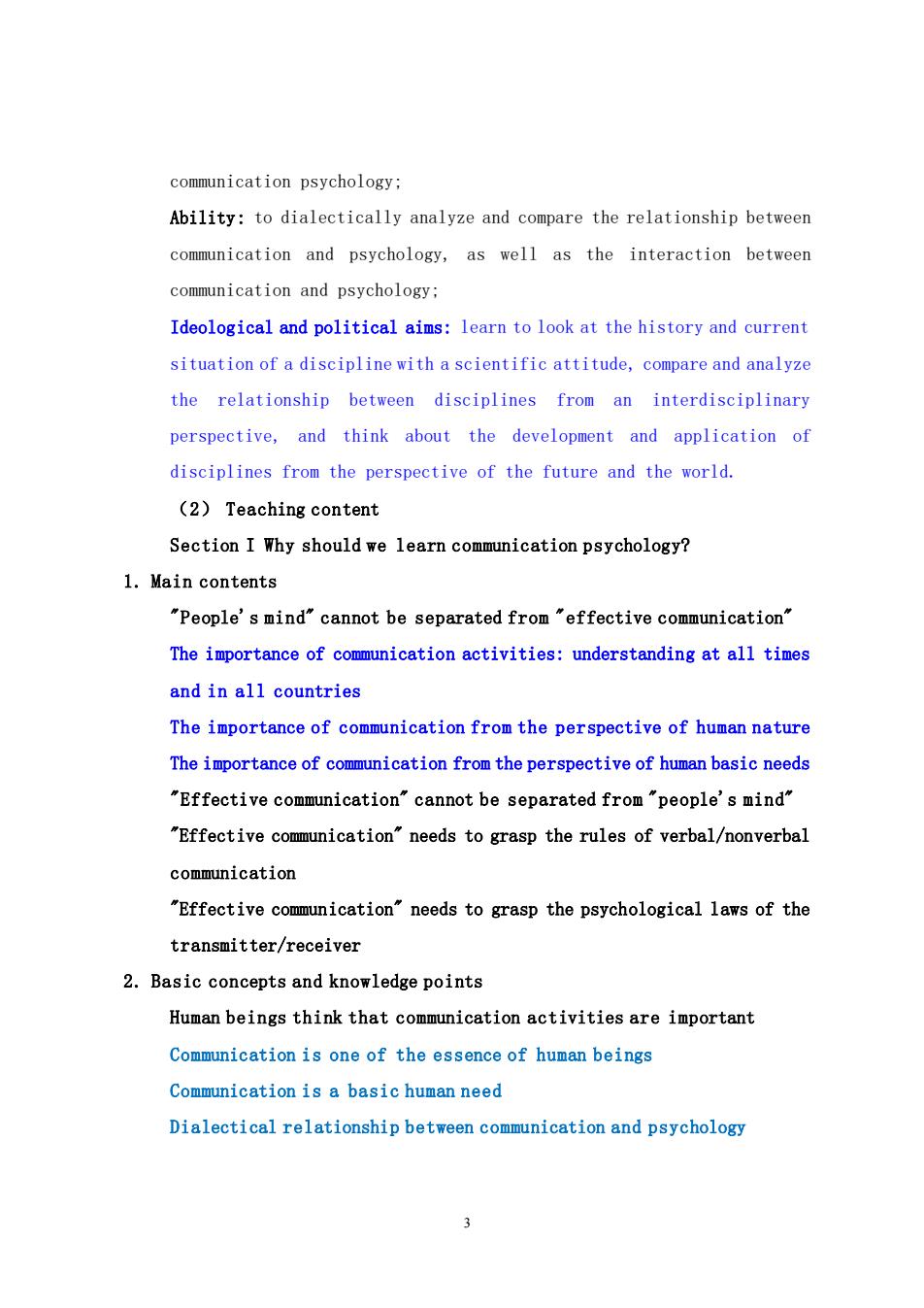
communication psychology: Ability:to dialectically analyze and compare the relationship between communication and psychology,as well as the interaction between communication and psychology: Ideological and political aims:learn to look at the history and current situation of a discipline with a scientific attitude,compare and analyze the relationship between disciplines from an interdisciplinary perspective,and think about the development and application of disciplines from the perspective of the future and the world. (2)Teaching content Section I Why should we learn communication psychology? 1.Main contents "People's mind"cannot be separated from"effective communication" The importance of communication activities:understanding at all times and in all countries The importance of communication from the perspective of human nature The importance of communication from the perspective of human basic needs "Effective communication"cannot be separated from "people's mind" "Effective communication"needs to grasp the rules of verbal/nonverbal communication "Effective communication"needs to grasp the psychological laws of the transmitter/receiver 2.Basic concepts and knowledge points Human beings think that communication activities are important Communication is one of the essence of human beings Communication is a basic human need Dialectical relationship between communication and psychology 3
3 communication psychology; Ability: to dialectically analyze and compare the relationship between communication and psychology, as well as the interaction between communication and psychology; Ideological and political aims: learn to look at the history and current situation of a discipline with a scientific attitude, compare and analyze the relationship between disciplines from an interdisciplinary perspective, and think about the development and application of disciplines from the perspective of the future and the world. (2) Teaching content Section I Why should we learn communication psychology? 1. Main contents "People's mind" cannot be separated from "effective communication" The importance of communication activities: understanding at all times and in all countries The importance of communication from the perspective of human nature The importance of communication from the perspective of human basic needs "Effective communication" cannot be separated from "people's mind" "Effective communication" needs to grasp the rules of verbal/nonverbal communication "Effective communication" needs to grasp the psychological laws of the transmitter/receiver 2. Basic concepts and knowledge points Human beings think that communication activities are important Communication is one of the essence of human beings Communication is a basic human need Dialectical relationship between communication and psychology

3.Problems and applications(capability requirements) Discussion:How do communication activities relate to various psychological needs of human beings? Section II Relationship between Communication and Psychology 1.Main contents About Communication About Psychology The Influence of Psychology on Communication The Influence of Communication on Psychology 2.Basic concepts and knowledge points The birth,development and discipline basis of communication science The birth,development and research purpose of psychology Dialectical relationship between communication and psychology The Influence of Psychological Theory,Characters and Research Methods on Communication Communication studies influence the research problems of psychology, expand its fields and perspectives 3.Problems and applications (capability requirements) How toeffectively apply psychological research methods to communication research? How does the study of network in communication science expand the scope of psychological research? What psychological topics have been added to the study of mobile phones in communication science? Section 3 What is communication psychology? 1.Main contents 4
4 3. Problems and applications (capability requirements) Discussion: How do communication activities relate to various psychological needs of human beings? Section II Relationship between Communication and Psychology 1. Main contents About Communication About Psychology The Influence of Psychology on Communication The Influence of Communication on Psychology 2. Basic concepts and knowledge points The birth, development and discipline basis of communication science The birth, development and research purpose of psychology Dialectical relationship between communication and psychology The Influence of Psychological Theory, Characters and Research Methods on Communication Communication studies influence the research problems of psychology, expand its fields and perspectives 3. Problems and applications (capability requirements) How to effectively apply psychological research methods to communication research? How does the study of network in communication science expand the scope of psychological research? What psychological topics have been added to the study of mobile phones in communication science? Section 3 What is communication psychology? 1. Main contents
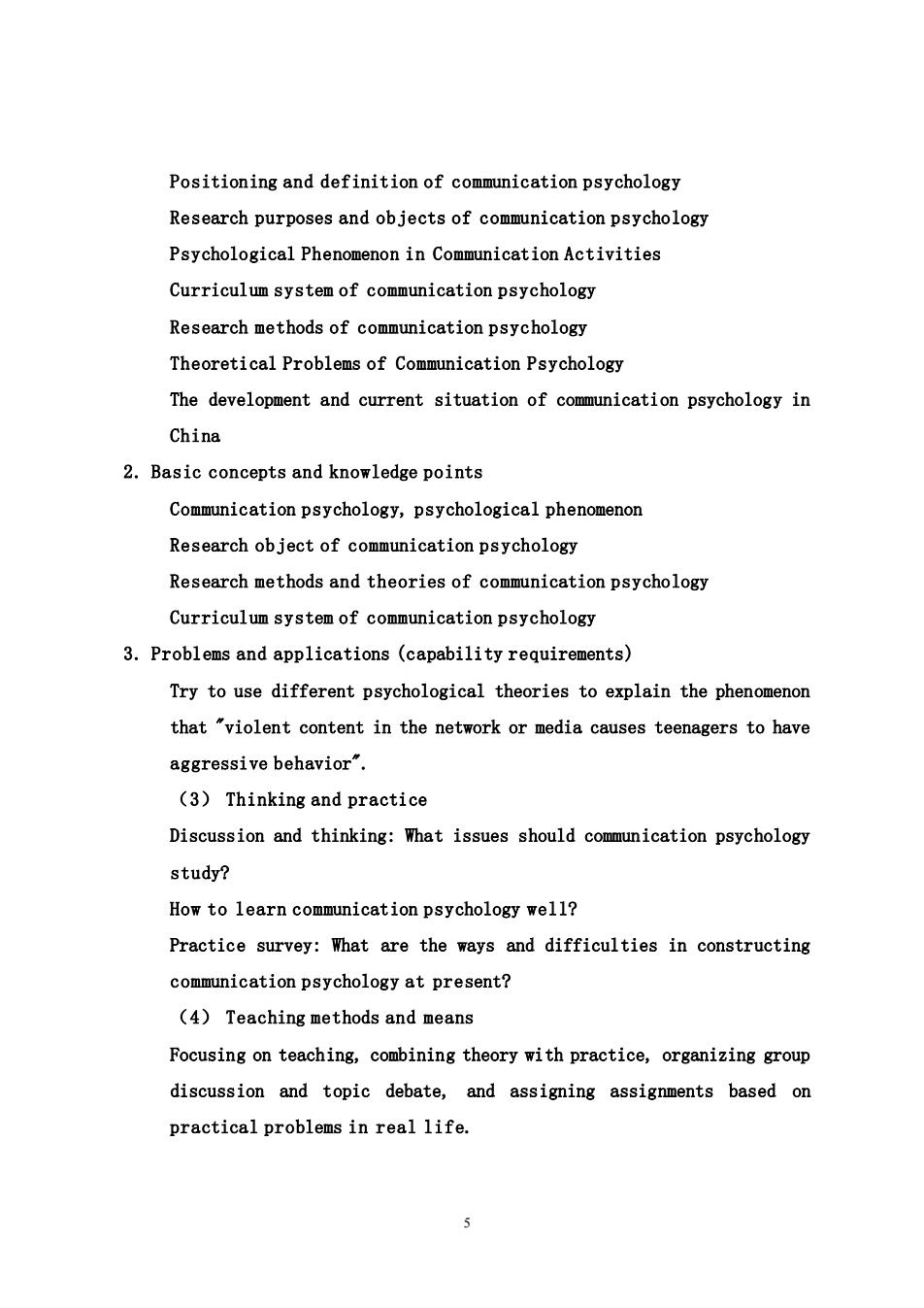
Positioning and definition of communication psychology Research purposes and objects of communication psychology Psychological Phenomenon in Communication Activities Curriculum system of communication psychology Research methods of communication psychology Theoretical Problems of Communication Psychology The development and current situation of communication psychology in China 2.Basic concepts and knowledge points Communication psychology,psychological phenomenon Research object of communication psychology Research methods and theories of communication psychology Curriculum system of communication psychology 3.Problems and applications(capability requirements) Try to use different psychological theories to explain the phenomenon that "violent content in the network or media causes teenagers to have aggressive behavior" (3)Thinking and practice Discussion and thinking:What issues should communication psychology study? How to learn communication psychology well? Practice survey:What are the ways and difficulties in constructing communication psychology at present? (4)Teaching methods and means Focusing on teaching,combining theory with practice,organizing group discussion and topic debate,and assigning assignments based on practical problems in real life. 5
5 Positioning and definition of communication psychology Research purposes and objects of communication psychology Psychological Phenomenon in Communication Activities Curriculum system of communication psychology Research methods of communication psychology Theoretical Problems of Communication Psychology The development and current situation of communication psychology in China 2. Basic concepts and knowledge points Communication psychology, psychological phenomenon Research object of communication psychology Research methods and theories of communication psychology Curriculum system of communication psychology 3. Problems and applications (capability requirements) Try to use different psychological theories to explain the phenomenon that "violent content in the network or media causes teenagers to have aggressive behavior". (3) Thinking and practice Discussion and thinking: What issues should communication psychology study? How to learn communication psychology well? Practice survey: What are the ways and difficulties in constructing communication psychology at present? (4) Teaching methods and means Focusing on teaching, combining theory with practice, organizing group discussion and topic debate, and assigning assignments based on practical problems in real life
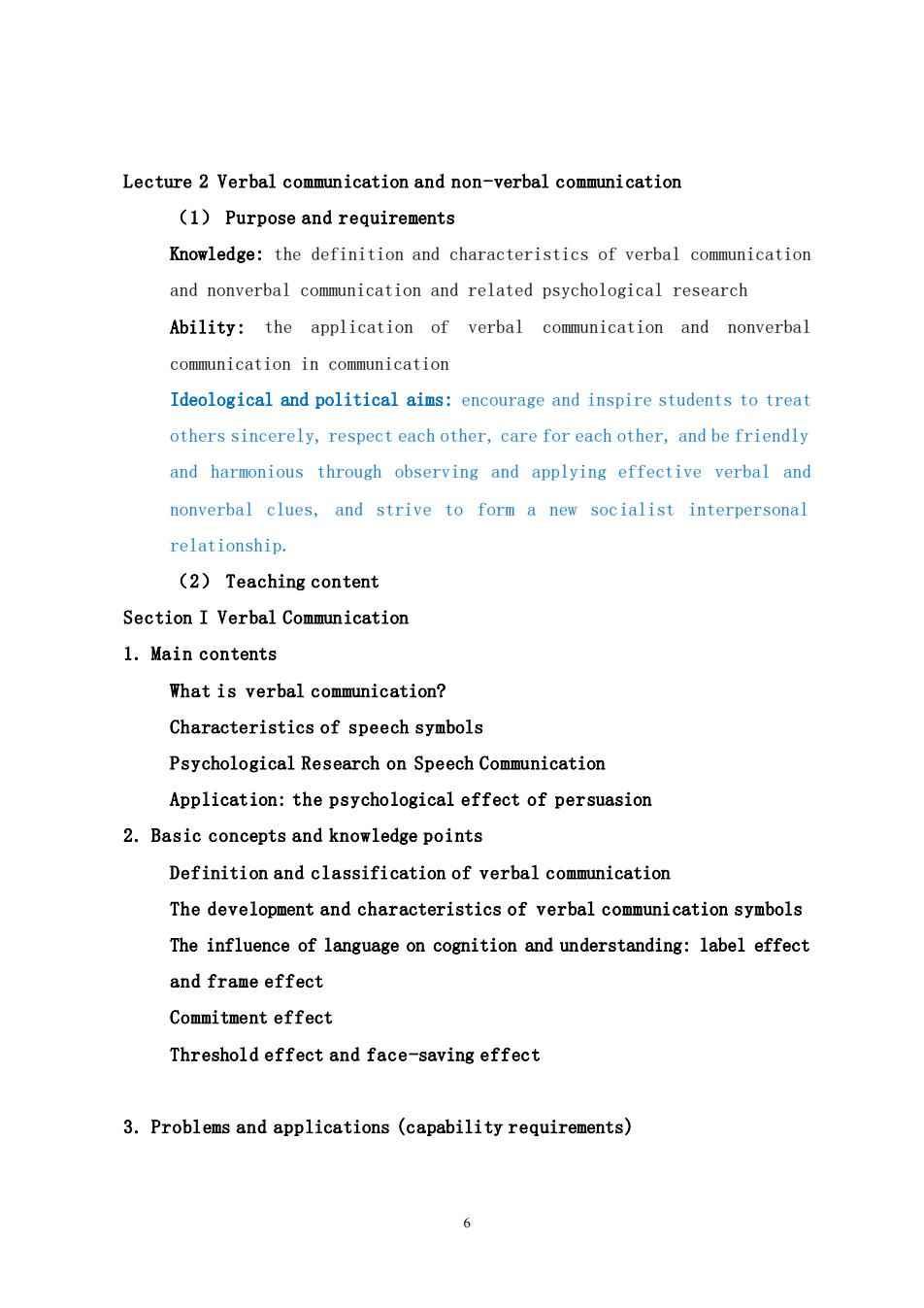
Lecture 2 Verbal communication and non-verbal communication (1)Purpose and requirements Knowledge:the definition and characteristics of verbal communication and nonverbal communication and related psychological research Ability:the application of verbal communication and nonverbal communication in communication Ideological and political aims:encourage and inspire students to treat others sincerely,respect each other,care for each other,and be friendly and harmonious through observing and applying effective verbal and nonverbal clues,and strive to form a new socialist interpersonal relationship. (2)Teaching content Section I Verbal Communication 1.Main contents What is verbal communication? Characteristics of speech symbols Psychological Research on Speech Communication Application:the psychological effect of persuasion 2.Basic concepts and knowledge points Definition and classification of verbal communication The development and characteristics of verbal communication symbols The influence of language on cognition and understanding:label effect and frame effect Commitment effect Threshold effect and face-saving effect 3.Problems and applications (capability requirements)
6 Lecture 2 Verbal communication and non-verbal communication (1) Purpose and requirements Knowledge: the definition and characteristics of verbal communication and nonverbal communication and related psychological research Ability: the application of verbal communication and nonverbal communication in communication Ideological and political aims: encourage and inspire students to treat others sincerely, respect each other, care for each other, and be friendly and harmonious through observing and applying effective verbal and nonverbal clues, and strive to form a new socialist interpersonal relationship. (2) Teaching content Section I Verbal Communication 1. Main contents What is verbal communication? Characteristics of speech symbols Psychological Research on Speech Communication Application: the psychological effect of persuasion 2. Basic concepts and knowledge points Definition and classification of verbal communication The development and characteristics of verbal communication symbols The influence of language on cognition and understanding: label effect and frame effect Commitment effect Threshold effect and face-saving effect 3. Problems and applications (capability requirements)
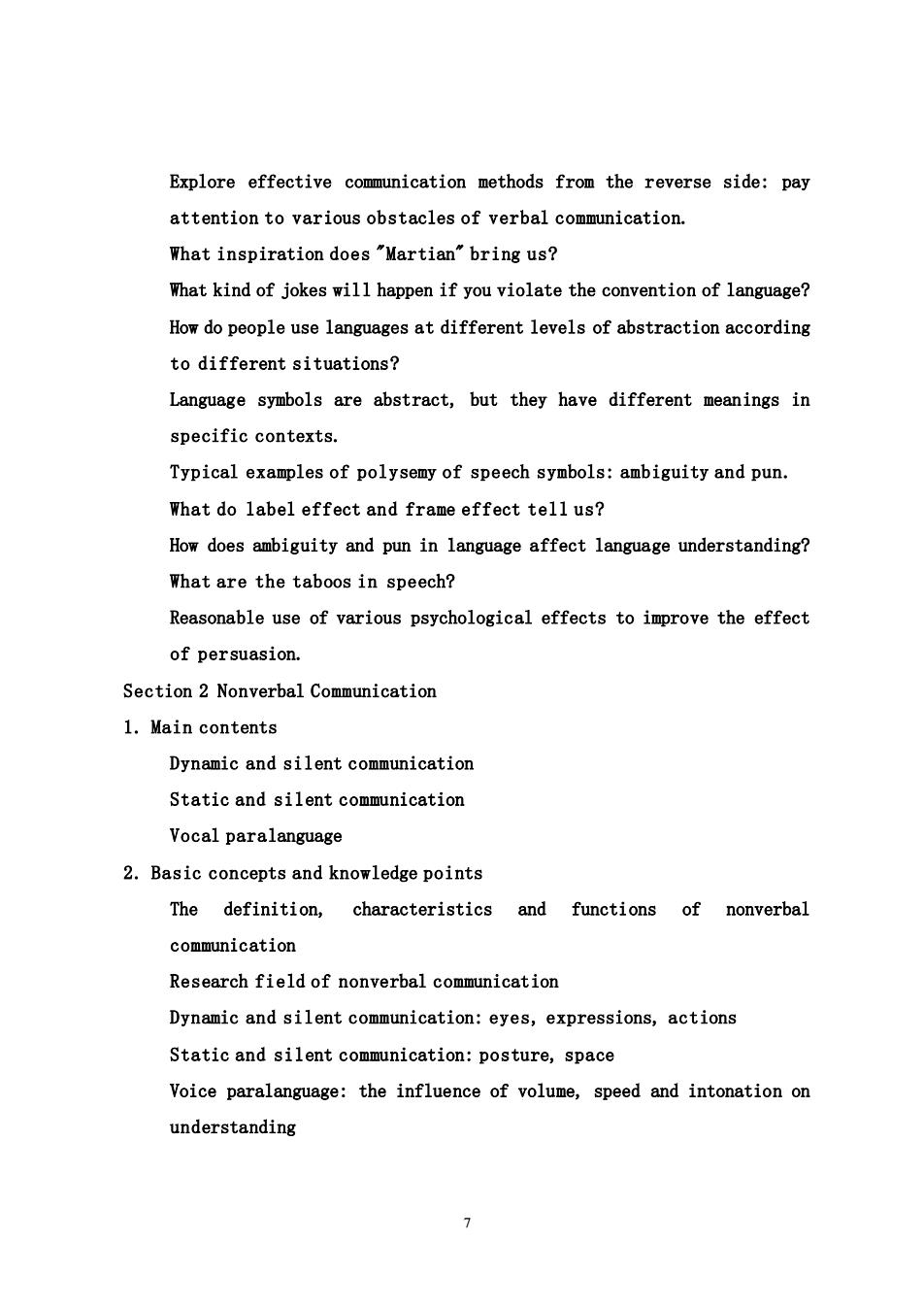
Explore effective communication methods from the reverse side:pay attention to various obstacles of verbal communication What inspiration does "Martian"bring us? What kind of jokes will happen if you violate the convention of language? How do people use languages at different levels of abstraction according to different situations? Language symbols are abstract,but they have different meanings in specific contexts. Typical examples of polysemy of speech symbols:ambiguity and pun. What do label effect and frame effect tell us? How does ambiguity and pun in language affect language understanding? What are the taboos in speech? Reasonable use of various psychological effects to improve the effect of persuasion. Section 2 Nonverbal Communication 1.Main contents Dynamic and silent communication Static and silent communication Vocal paralanguage 2.Basic concepts and knowledge points The definition, characteristics and functions of nonverbal communication Research field of nonverbal communication Dynamic and silent communication:eyes,expressions,actions Static and silent communication:posture,space Voice paralanguage:the influence of volume,speed and intonation on understanding 7
7 Explore effective communication methods from the reverse side: pay attention to various obstacles of verbal communication. What inspiration does "Martian" bring us? What kind of jokes will happen if you violate the convention of language? How do people use languages at different levels of abstraction according to different situations? Language symbols are abstract, but they have different meanings in specific contexts. Typical examples of polysemy of speech symbols: ambiguity and pun. What do label effect and frame effect tell us? How does ambiguity and pun in language affect language understanding? What are the taboos in speech? Reasonable use of various psychological effects to improve the effect of persuasion. Section 2 Nonverbal Communication 1. Main contents Dynamic and silent communication Static and silent communication Vocal paralanguage 2. Basic concepts and knowledge points The definition, characteristics and functions of nonverbal communication Research field of nonverbal communication Dynamic and silent communication: eyes, expressions, actions Static and silent communication: posture, space Voice paralanguage: the influence of volume, speed and intonation on understanding
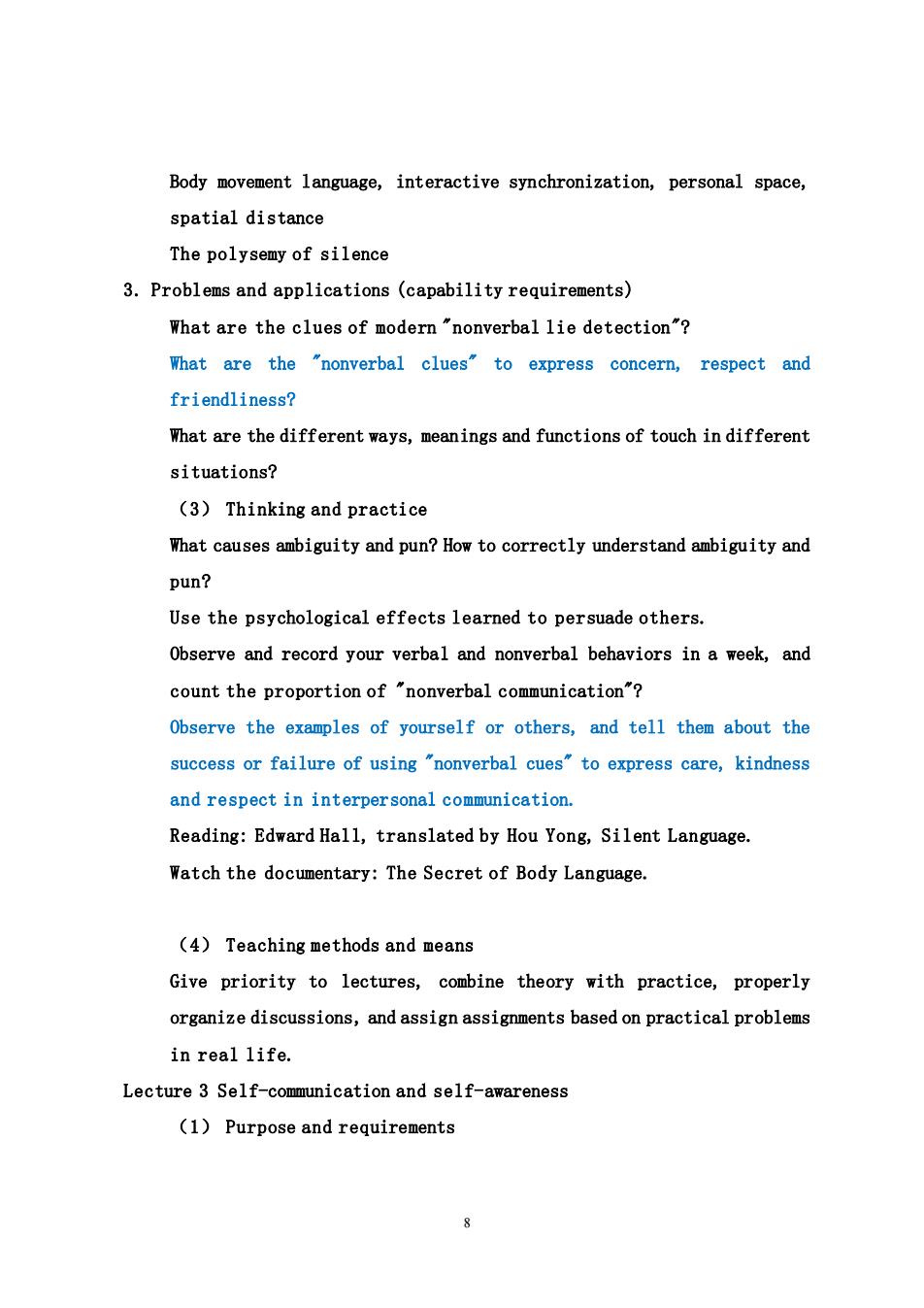
Body movement language,interactive synchronization,personal space, spatial distance The polysemy of silence 3.Problems and applications (capability requirements) What are the clues of modern"nonverbal lie detection"? What are the "nonverbal clues"to express concern,respect and friendliness? What are the different ways,meanings and functions of touch in different situations? (3)Thinking and practice What causes ambiguity and pun?How to correctly understand ambiguity and pun? Use the psychological effects learned to persuade others. Observe and record your verbal and nonverbal behaviors in a week,and count the proportion of "nonverbal communication"? Observe the examples of yourself or others,and tell them about the success or failure of using "nonverbal cues"to express care,kindness and respect in interpersonal communication. Reading:Edward Hall,translated by Hou Yong,Silent Language Watch the documentary:The Secret of Body Language. (4)Teaching methods and means Give priority to lectures,combine theory with practice,properly organize discussions,and assign assignments based on practical problems in real life. Lecture 3 Self-communication and self-awareness (1)Purpose and requirements
8 Body movement language, interactive synchronization, personal space, spatial distance The polysemy of silence 3. Problems and applications (capability requirements) What are the clues of modern "nonverbal lie detection"? What are the "nonverbal clues" to express concern, respect and friendliness? What are the different ways, meanings and functions of touch in different situations? (3) Thinking and practice What causes ambiguity and pun? How to correctly understand ambiguity and pun? Use the psychological effects learned to persuade others. Observe and record your verbal and nonverbal behaviors in a week, and count the proportion of "nonverbal communication"? Observe the examples of yourself or others, and tell them about the success or failure of using "nonverbal cues" to express care, kindness and respect in interpersonal communication. Reading: Edward Hall, translated by Hou Yong, Silent Language. Watch the documentary: The Secret of Body Language. (4) Teaching methods and means Give priority to lectures, combine theory with practice, properly organize discussions, and assign assignments based on practical problems in real life. Lecture 3 Self-communication and self-awareness (1) Purpose and requirements
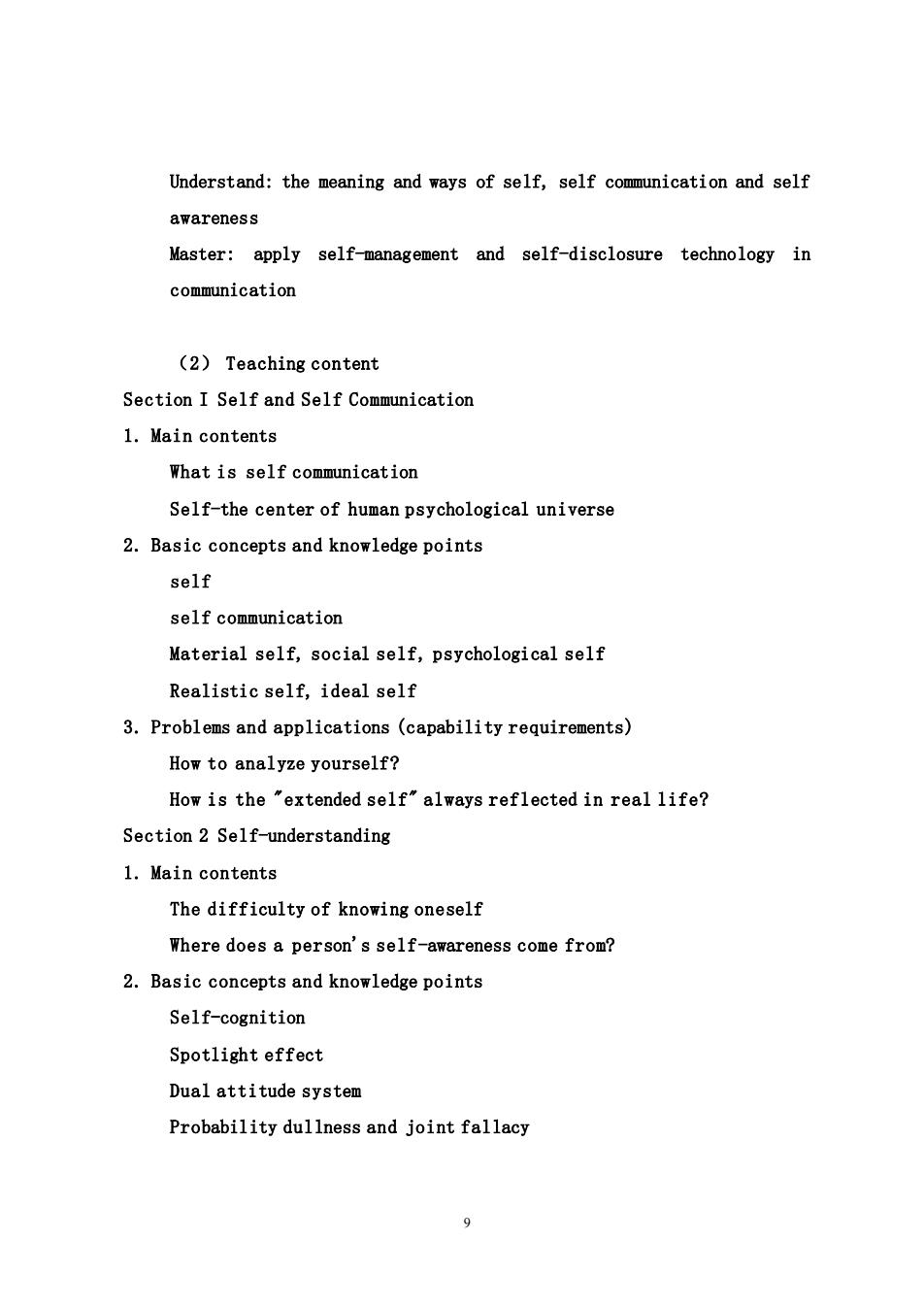
Understand:the meaning and ways of self,self communication and self awareness Master:apply self-management and self-disclosure technology in communication (2)Teaching content Section I Self and Self Communication 1.Main contents What is self communication Self-the center of human psychological universe 2.Basic concepts and knowledge points self self communication Material self,social self,psychological self Realistic self,ideal self 3.Problems and applications (capability requirements) How to analyze yourself? How is the "extended self"always reflected in real life? Section 2 Self-understanding 1.Main contents The difficulty of knowing oneself Where does a person's self-awareness come from? 2.Basic concepts and knowledge points Self-cognition Spotlight effect Dual attitude system Probability dullness and joint fallacy 9
9 Understand: the meaning and ways of self, self communication and self awareness Master: apply self-management and self-disclosure technology in communication (2) Teaching content Section I Self and Self Communication 1. Main contents What is self communication Self-the center of human psychological universe 2. Basic concepts and knowledge points self self communication Material self, social self, psychological self Realistic self, ideal self 3. Problems and applications (capability requirements) How to analyze yourself? How is the "extended self" always reflected in real life? Section 2 Self-understanding 1. Main contents The difficulty of knowing oneself Where does a person's self-awareness come from? 2. Basic concepts and knowledge points Self-cognition Spotlight effect Dual attitude system Probability dullness and joint fallacy

Compliance,identification and internalization Social comparison and reflective evaluation Self-perception attribution 3.Problems and applications(capability requirements) What influence does society have on self? How does social comparison and reflective evaluation affect self-cognition? How do cultural differences affect self-perception? In what ways do socialist core values affect your self-perception? Section III Self-management:control behavior and interpretation behavior 1.Main contents Self-efficacy Learned helplessness control point Self-determination and regret of choice 2.Basic concepts and knowledge points Self-efficacy Learned helplessness control point Self-determination 3.Problems and applications(capability requirements) Self-selection:Is more TV channels better? What is the relationship between self-efficacy,self-confidence and inferiority? How to avoid the learned helplessness of the audience in the process of communication? 10
10 Compliance, identification and internalization Social comparison and reflective evaluation Self-perception attribution 3. Problems and applications (capability requirements) What influence does society have on self? How does social comparison and reflective evaluation affect self-cognition? How do cultural differences affect self-perception? In what ways do socialist core values affect your self-perception? Section III Self-management: control behavior and interpretation behavior 1. Main contents Self-efficacy Learned helplessness control point Self-determination and regret of choice 2. Basic concepts and knowledge points Self-efficacy Learned helplessness control point Self-determination 3. Problems and applications (capability requirements) Self-selection: Is more TV channels better? What is the relationship between self-efficacy, self-confidence and inferiority? How to avoid the learned helplessness of the audience in the process of communication?